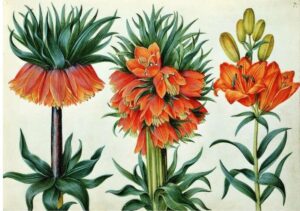
Experimental art can take many different forms. Usually, an artist will take an unusual item and make it into a different form. Painting with plants a form of experimental art where a flower or leaf is turned into paint that looks a lot like watercolors.
This process can be very fun and freeing for an artist that usually paints with just a brush and traditional paints. Here is how to get started painting with plants and how to manipulate it into a finished piece that suits the artist’s style.
Equipment
The equipment used for botanical painting is very simple. The artist needs:
- A hammer
- Watercolor paper (cold pressed 140 lbs. Strathmore Watercolor Artist Trading Cards are used in the examples)
- Wax paper (slick computer paper works, too)
- Fresh flowers
- Fresh leaves (fuzzy, thick leaves work better than glossy leaves)
Smashing
Smashing uses a hammer to extract juices from plants and flowers to dye the watercolor paper. The first step is to lay the plant onto the watercolor paper. Then, the plant is covered with the wax paper. The artist can then beat the flower with the hammer as much as they like to get as much or as little pigment on the paper as needed. The finished product can be seen in Example One.
Rubbing
Rubbing also extracts the juices from the plants, but it uses a different method. The artist can tear apart the plant and forcibly rub it onto the watercolor paper to create an interesting wash of color. The results of this technique can be seen in Example Two.
After the wash of color is laid down, the artist can draw or paint on top of it.
Layering
Several different plants can be layered to achieve different effects. For example, in Example Three the artist first smashed a watermelon leaf onto the paper. Then, the petals of an orange flower were rubbed on top of the leaf print to create the look of an abstract flower.
Manipulating
The artist can manipulate botanical paintings to make them part of a more elaborate painting by adding mixed media. In Example Four, the artist used a felt tip pen to add detail to the painting. Other media, such as watercolor, ink, and acrylics, can be added to manipulate the look of the piece.
This style of experimental art can be very random and can call for a lot of practice and testing to get pleasing effects. This is a good exercise for bringing the artist out of their usual thought patterns. The result can be a new way of thinking and some very creative art.
